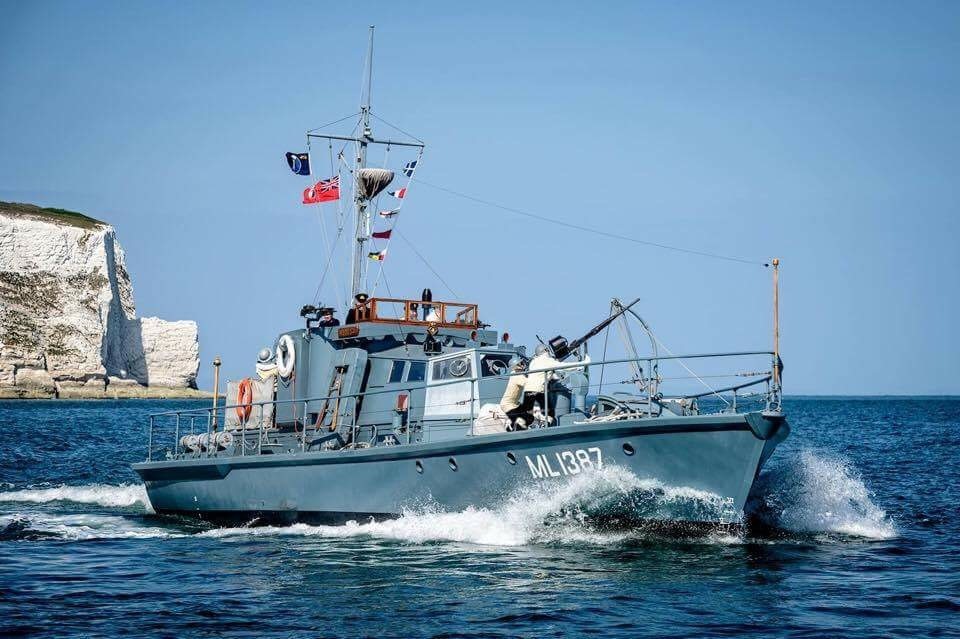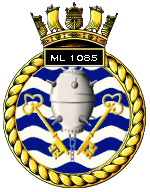Defending and Attacking aboard ML1085
HDML’s were built with two primary methods of harbour defence in mind, their twin mounts of 20mm Oerlikon Cannons provided convincing anti aircraft capability for a vessel of their size. With several recorded accounts of Luftwaffe aircraft being downed by them. Their second method of defending harbours and waterways, was against submarine attack, this had been proven particularly devastating in Scapa Flow with the loss of HMS Royal Oak at anchor early in the war. Amongst many other deterrents hurriedly introduced to counter this threat, the 190th squadron benefitted from several HDML’s which were equipped with the MK VI TNT depth charge, smaller than a standard depth charge, it was able to be mounted on the aft deck of the HDML, this meant they could carry eight at a time, it did clutter the deck considerably but a worthwhile sacrifice, as when coupled with the new Asdic eco location system, they made very effective submarine chasers! As with the Luftwaffe threat there are also several accounts of HDML’s having confirmed sinking’s of U-boats, even during the Normandy landings. It could be tricky to release them in an unsteady sea, and the ship needed to be traveling at Full Ahead to escape damage from the shock wave, the stern was reinforced and the ships sides extended outwards to alloy the depth charges to “roll” away to sink away from the ships side. But you certainly didn’t want to be nearby when it blew, especially if you were lucky enough to detonate the submarines own ordinance!

The Fwd 20mm Oerlikon was afforded a good deck area where the gun crew could easily wield it from port to starboard, to switch aim from different incoming targets, or slew it quickly to follow the track of an overflying hostile aircraft to continue the engagement. However the Aft Cannon posed far more restrictions, firstly the depth charges were mounted either side on the lower deck, providing a much narrower platform when engaging targets abeam. Under normal cruising the guardrails were also placed around this deck, but most of all the ammunition lockers are mount slightly aft and outboard of the Oerlikons deck mount which would hinder any attempt to train fire onto a target fwd of Green 90º or Red 90º although the bridge crew would have been grateful for this, as it would of greatly narrowed the chance of them coming into the aft cannon sights, leaving only the more flexible Fwd cannon to worry about.
Originally fitted with the Navy 2pdr Quick Firing deck gun, this was quickly replaced due to its inaccuracy on such a small vessel, the were replaced with 3pdr and some 6 pdr’s were fitted, however with the increased threat from the Luftwaffe an effective Anti Aircraft weapon was needed and so the 20mm fitted aft was also fitted Fwd having proved itself in the role. This formed the standard fot of armament used on HDML’s for most of them, however in the different theatres of the war they served in, o9ther adaptations were made.

Here you can see two HDML’s alongside fitted with a 40mm Bofors to the foredeck, this provided far greater firepower against enemy vessels of an equivalent size, and were far more effective against airborne targets, effectively doubling the size of the shells capable of being fired from the earlier 20mm Oerlikons. To take the extra weight and recoil of the Bofors extra supports were fitted below the deck in the JR mess, however this was not possible in the wardroom, and the Oerlikon remained as the main armament aft , as it also had a higher rate of fire than the Bofors. Rivets from additional armour plating can be seen on the wheel house to its sides and roof.
